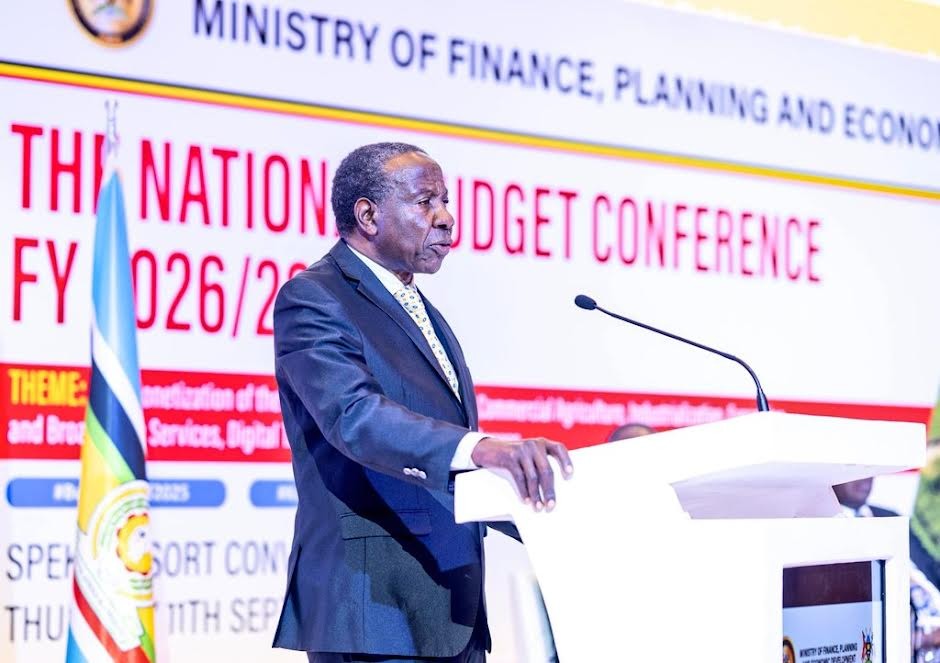KAMPALA, September 15, 2025 – Finance Minister Matia Kasaija has reassured Ugandans that the country’s rising public debt remains sustainable, despite growing concerns over increased government borrowing.
Speaking on Thursday at the opening of the National Budget Conference for the Financial Year 2026/2027, held at the Speke Resort Convention Centre, Kasaija revealed that Uganda’s total debt stock had significantly increased over the past year, but still remains within acceptable thresholds.
“As of the end of June 2025, the total public debt stood at US$ 32.33 billion [about Shs 116.21 trillion], up from US$ 25.63 billion [Shs 94.72trn] at the end of June 2024,” said Kasaija.
He further explained, “Of this, domestic debt amounted to US$ 16.8 billion [about Shs 60.34trn], while external debt stood at US$ 15.54 billion [about Shs 55.88trn]. This represents a debt-to-GDP ratio of 51.3 percent, which remains within sustainable limits in the short to medium term.”
The Minister attributed the increase to heightened investment in large-scale infrastructure projects, noting a significant rise in the proportion of domestic borrowing.
“The share of domestic debt as a percentage of total public debt rose to 51.9 percent by June 2025, up from 42.9 percent the previous year. This aligns with the approved Medium-Term Debt Strategy and the annual borrowing plan,” Kasaija said.
Despite the sharp increase, he emphasised that all government borrowing continues to be guided by a strict fiscal strategy aimed at balancing development needs with long-term sustainability.
“The rise in public debt reflects increased external disbursements and expanded domestic borrowing to finance key infrastructure projects,” he noted, stressing that Uganda’s debt sustainability frameworks remain intact.
During the conference, Kasaija also unveiled Uganda’s Tenfold Growth Strategy, a bold economic roadmap aimed at transforming the country into an upper-middle-income economy by 2040.
“Uganda has diversified its export base beyond the traditional ‘three Cs’—coffee, cotton, and copper, and the ‘three Ts’—tea, tourism, and tobacco. We are now tapping into regional and continental markets, under a shared national vision to grow the economy tenfold by 2040,” he announced.
The strategy focuses on enhancing value addition, accelerating innovation, investing in key enablers such as energy and transport, and strengthening regional integration. It aims to boost economic growth to 7 percent in FY 2025/26, with expectations of double-digit growth once commercial oil production begins in 2026.
On her part, Prime Minister Robinah Nabbanja called on all government ministries and agencies to align their programmes with the new national priorities while reducing overreliance on debt.
“It is our collective responsibility to drive implementation in key anchor sectors such as agro-industrialisation, tourism, mineral-based industries, and science, technology, and innovation. We must improve revenue collection to secure Uganda’s development pathway,” she said.
With the public debt now at Shs 116.21trn and the borrowing still on the rise, the government is banking on its new fiscal strategy, structural reforms, and anticipated oil revenues to stimulate economic growth while keeping public debt within manageable bounds.
https://thecooperator.news/public-debt-takes-lions-share-of-ugandas-shs-72-trillion-budget/
Buy your copy of thecooperator magazine from one of our country-wide vending points or an e-copy on emag.thecooperator.news
